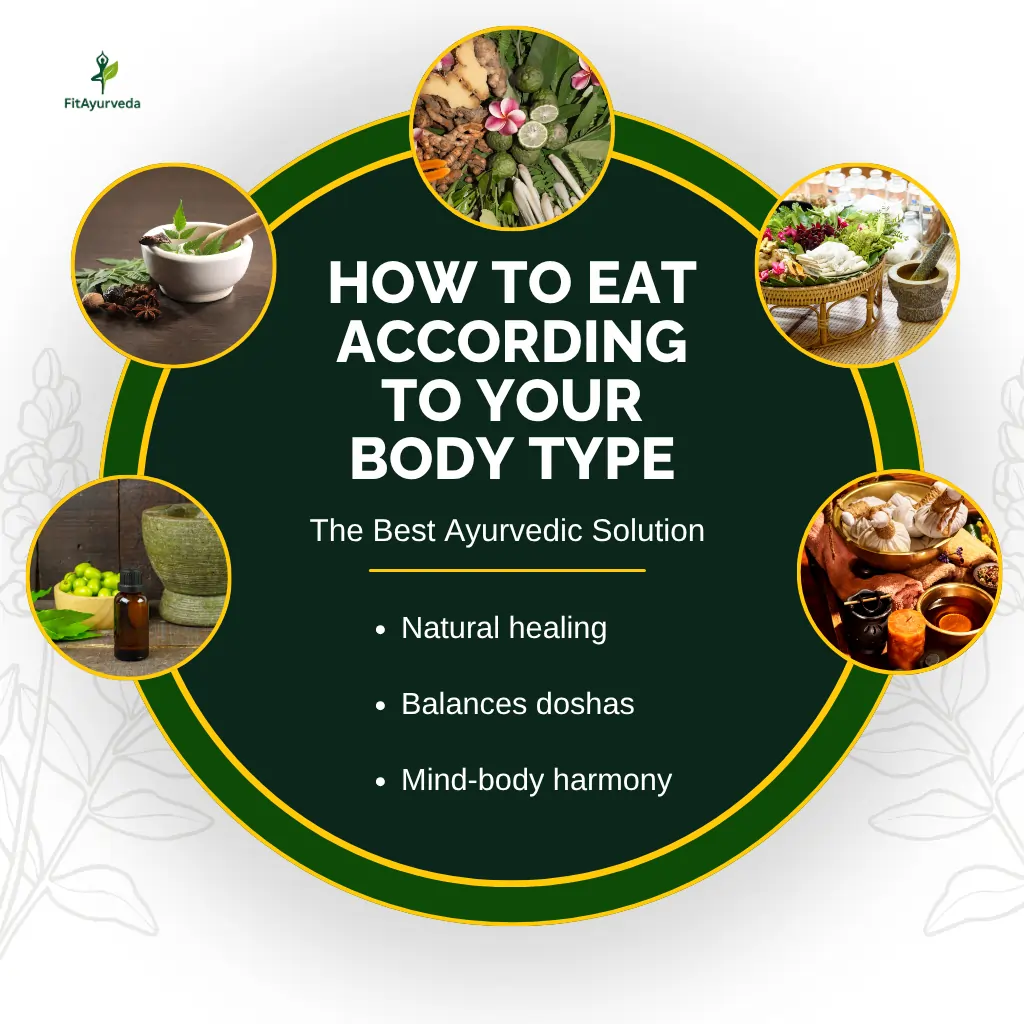How to Eat According to Your Body Type (Vata, Pitta, Kapha): Understanding Food as Medicine
In Ayurveda, food is not just fuel — it’s medicine.
Every bite we take can either nourish our body or disturb its delicate balance. Ayurveda teaches that our health depends not only on what we eat, but also how and when we eat.
Each of us is born with a unique constitution known as Prakriti, which is governed by three fundamental energies — Vata, Pitta, and Kapha. These are called the doshas, and they control every function of our body and mind — from digestion and sleep to mood and immunity.
When our doshas are balanced, we experience vitality, clarity, and inner peace. But when they go out of balance, health problems appear — such as fatigue, poor digestion, weight gain, anxiety, or skin issues.
The secret to true health lies in eating according to your body type — aligning your diet and lifestyle with your dominant dosha.
In this comprehensive guide, you’ll learn:
✅ How to identify your Ayurvedic body type
✅ What each dosha means and how it affects your health
✅ The ideal foods, routines, and habits for Vata, Pitta, and Kapha types
✅ Universal Ayurvedic eating rules and seasonal diet tips
Let’s begin your journey toward conscious eating and inner harmony.
Also Read: How to Do an Ayurvedic Detox at Home
What Are Doshas? Foundation of Ayurvedic Body Types
In Ayurveda, everything in the universe — including our body — is made up of the five elements: Ether (space), Air, Fire, Water, and Earth.
These elements combine to form the three doshas:
| Dosha | Elements | Main Qualities | Functions |
|---|---|---|---|
| Vata | Air + Ether | Light, dry, cold, mobile, subtle | Movement, communication, nervous system |
| Pitta | Fire + Water | Hot, sharp, oily, intense | Digestion, metabolism, transformation |
| Kapha | Water + Earth | Heavy, slow, cool, stable | Structure, lubrication, immunity |
Each person has all three doshas, but usually one or two are dominant. That dominant combination defines your Prakriti — your natural body-mind constitution.
The Vata Type — The Wind Energy
Understanding Vata
Vata represents movement and creativity. It governs breathing, circulation, elimination, and communication in the body. People with a Vata-dominant constitution are imaginative, quick thinkers, and full of enthusiasm — but they can also become anxious or scattered when out of balance.
Characteristics of Vata Individuals
-
Thin, light body frame
-
Dry skin, cold hands and feet
-
Irregular appetite and digestion
-
Creative, talkative, quick to learn
-
Tendency toward anxiety or insomnia
When balanced: Energetic, adaptable, joyful, imaginative
When imbalanced: Fearful, restless, fatigued, constipated
Best Foods for Vata Body Type
Vata is dry, light, and cold, so its balance requires foods that are warm, moist, grounding, and nourishing.
| Category | Recommended | Avoid / Limit |
|---|---|---|
| Grains | Rice, oats, quinoa, wheat | Barley, corn, buckwheat |
| Vegetables | Cooked carrots, sweet potatoes, beets | Raw vegetables, cabbage, cauliflower |
| Fruits | Ripe bananas, mangoes, papayas | Raw apples, cranberries, pears |
| Dairy | Warm milk, ghee, paneer | Cold milk, ice cream |
| Spices | Ginger, cumin, cinnamon, clove | Bitter or very astringent spices |
| Oils | Sesame oil, olive oil, ghee | Refined or cold-pressed oils |
| Drinks | Warm herbal teas (ginger, fennel) | Cold, fizzy, or caffeinated drinks |
Ideal Vata Day Plan
Morning: Warm water with lemon and a spoon of ghee
Breakfast: Oatmeal cooked with dates, almonds, and cinnamon
Lunch: Steamed rice, moong dal, and ghee
Evening: Herbal tea with snacks like roasted sweet potatoes
Lifestyle Tips for Vata
-
Keep yourself warm — avoid cold environments
-
Maintain a regular daily routine (Vata easily gets irregular)
-
Practice grounding yoga and meditation
-
Sleep early and ensure 7–8 hours of rest
-
Stay hydrated with warm fluids
The Pitta Type — The Fire Energy
Understanding Pitta
Pitta governs digestion, metabolism, and body temperature. Its fiery nature gives Pitta people sharp intellect, ambition, and strong leadership qualities. However, excess heat can lead to irritability, inflammation, or acidity.
Characteristics of Pitta Individuals
-
Medium build, good muscle tone
-
Sharp intellect, strong willpower
-
Warm body temperature
-
Prone to anger or impatience
-
Tendency toward acne, acidity, or ulcers
When balanced: Intelligent, confident, motivated
When imbalanced: Angry, judgmental, overheated, inflamed
Best Foods for Pitta Body Type
Pitta is hot, sharp, and oily, so it benefits from cooling, light, and hydrating foods.
| Category | Recommended | Avoid / Limit |
|---|---|---|
| Grains | Rice, barley, oats | Corn, millet |
| Vegetables | Cucumber, broccoli, asparagus | Chili, garlic, onion |
| Fruits | Melons, grapes, pomegranates | Citrus fruits, papaya |
| Dairy | Milk, butter, ghee (moderate) | Fermented yogurt, sour cream |
| Spices | Fennel, coriander, cardamom | Chili, mustard, pepper |
| Oils | Coconut oil, sunflower oil | Sesame oil, peanut oil |
| Drinks | Coconut water, mint tea | Coffee, alcohol, hot drinks |
Ideal Pitta Day Plan
Morning: Cool water with aloe vera juice
Breakfast: Soaked chia seeds in coconut milk
Lunch: Rice with moong dal and cucumber salad
Evening: Fresh fruit smoothie or mint tea
Lifestyle Tips for Pitta
-
Avoid spicy, oily, and fried foods
-
Stay cool — physically and emotionally
-
Don’t skip meals (Pitta gets irritable when hungry)
-
Practice calming yoga and meditation
-
Take short breaks from work or screen time
The Kapha Type — The Earth Energy
Understanding Kapha
Kapha governs structure, strength, and stability. People with dominant Kapha are calm, compassionate, and grounded. However, excess Kapha can cause sluggishness, weight gain, or emotional heaviness.
Characteristics of Kapha Individuals
-
Strong, solid body frame
-
Calm, patient, and loyal
-
Slow metabolism and digestion
-
Tendency toward congestion or weight gain
When balanced: Loving, peaceful, emotionally steady
When imbalanced: Lazy, possessive, depressed, overweight
Best Foods for Kapha Body Type
Kapha is heavy, cool, and oily, so it needs light, warm, and stimulating foods.
| Category | Recommended | Avoid / Limit |
|---|---|---|
| Grains | Barley, millet, quinoa | Rice, wheat |
| Vegetables | Leafy greens, peppers, onions | Potatoes, sweet potatoes |
| Fruits | Apples, pears, berries | Bananas, melons |
| Dairy | Minimal; prefer light milk | Cheese, butter, yogurt |
| Spices | Ginger, turmeric, black pepper | Salt-heavy spices, sugar |
| Oils | Mustard oil, flaxseed oil | Coconut oil, heavy fats |
| Drinks | Warm ginger tea, honey water | Cold milkshakes or sodas |
Ideal Kapha Day Plan
Morning: Warm water with honey
Breakfast: Light fruit or herbal tea
Lunch: Steamed vegetables and lentil soup
Evening: Early, light dinner before 7 PM
Lifestyle Tips for Kapha
-
Stay active — exercise daily
-
Avoid sleeping during the day
-
Eat light, dry, and warm meals
-
Reduce sugar and dairy intake
-
Include energizing yoga and breathing practices
How to Identify Your Body Type
If you’re unsure of your dosha, observe your natural physical and emotional tendencies:
| Feature | Vata | Pitta | Kapha |
|---|---|---|---|
| Body Frame | Thin, light | Medium, muscular | Heavy, solid |
| Skin | Dry, rough | Warm, reddish | Soft, oily |
| Appetite | Irregular | Strong | Steady but slow |
| Mind | Creative, anxious | Focused, driven | Calm, loyal |
| Sleep | Light, disturbed | Moderate | Deep, long |
Tip: You can take a professional Ayurvedic assessment at Fit Ayurveda or consult a qualified practitioner for a precise dosha analysis.
Universal Ayurvedic Eating Tips
Regardless of your dosha, Ayurveda emphasizes Agni — your digestive fire — as the key to good health.
Follow these timeless eating principles to strengthen digestion and prevent toxin (Ama) buildup:
-
Eat freshly prepared, warm meals.
-
Avoid overeating or skipping meals.
-
Eat in a calm, seated position — no screens or distractions.
-
Start with lighter foods; end with heavier ones.
-
Sip warm water or herbal tea with meals (avoid cold drinks).
-
Don’t mix incompatible foods — like milk with citrus or salt with fruits.
-
Express gratitude before eating.
These simple habits keep your digestion smooth and your mind peaceful.
Seasonal and Time-Based Eating (Ritucharya)
Ayurveda recognizes that our internal energies shift with time and season. To stay balanced, adjust your diet accordingly.
Daily Rhythm
| Time of Day | Dominant Dosha | What to Eat |
|---|---|---|
| 6 AM – 10 AM (Kapha) | Heavy, sluggish | Light, warm breakfast |
| 10 AM – 2 PM (Pitta) | Strong digestion | Main meal of the day |
| 2 PM – 6 PM (Vata) | Light, dry | Small, grounding snack |
| 6 PM – 10 PM (Kapha) | Slow digestion | Early, light dinner |
Seasonal Diet Guidelines
-
Winter (Vata Season): Favor warm, oily, and hearty foods like soups and stews.
-
Summer (Pitta Season): Eat cooling foods like cucumber, melons, and coconut water.
-
Monsoon (Kapha Season): Include light, spicy, and dry meals to prevent sluggishness.
Aligning your food with nature’s rhythm enhances immunity and emotional stability.
Common Mistakes to Avoid
-
Mixing incompatible foods (e.g., milk + sour fruit)
-
Skipping or delaying meals
-
Eating late at night
-
Overeating or snacking continuously
-
Drinking cold water with meals
-
Reheating leftovers multiple times
Avoiding these habits helps maintain strong digestion and longevity.
Frequently Asked Questions
Q1. How do I know my exact dosha type?
→ You can consult an Ayurvedic practitioner or take an online dosha quiz. Observation and professional pulse diagnosis (Nadi Pariksha) give the most accurate results.
Q2. Can I have a mix of two doshas?
→ Yes, most people are dual types — such as Vata-Pitta or Kapha-Pitta. You should eat to balance the dosha that feels most aggravated or shows symptoms.
Q3. Can I eat non-vegetarian food in Ayurveda?
→ Yes, Ayurveda allows non-veg foods like chicken or fish for certain body types and seasons, but always in moderation and with proper digestion support (e.g., ginger, cumin).
Q4. What happens if I eat against my body type?
→ You may experience symptoms like acidity, bloating, fatigue, or mood swings. Aligning your diet with your dosha restores harmony naturally.
Q5. How long does it take to see results?
→ Most people feel improvement within 2–4 weeks of following a dosha-specific diet, consistent routine, and mindful eating.
Conclusion: Balance Begins with Awareness
Understanding your body type (Prakriti) is the foundation of true wellness.
When you eat in harmony with your dosha, your body functions effortlessly — digestion improves, sleep deepens, skin glows, and your mind becomes calm.
Ayurveda reminds us:
“When diet is wrong, medicine is of no use. When diet is correct, medicine is of no need.”
Start by observing your body. Make small, consistent dietary adjustments.
Soon, you’ll experience how nature’s wisdom — when applied through food — becomes your greatest healer.
Ayurveda identifies three doshas — Vata, Pitta, and Kapha — as the primary forces that shape your body and mind. You can read more about them on The Ayurvedic Institute’s guide to doshas.

